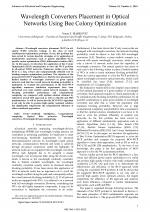| 1/2016 - 1 | View TOC | « Previous Article | Next Article » |
Wavelength Converters Placement in Optical Networks Using Bee Colony OptimizationMARKOVIC, G. Z. |
| Extra paper information in |
| Click to see author's profile in |
| Download PDF |
Author keywords
artificial intelligence, computational complexity, optical fiber networks, wavelength converters, wavelength division multiplexing
References keywords
wavelength(26), networks(22), optical(19), placement(14), converter(11), communications(9), converters(7), algorithm(7), optimal(6), optimization(5)
Blue keywords are present in both the references section and the paper title.
About this article
Date of Publication: 2016-02-28
Volume 16, Issue 1, Year 2016, On page(s): 3 - 10
ISSN: 1582-7445, e-ISSN: 1844-7600
Digital Object Identifier: 10.4316/AECE.2016.01001
Web of Science Accession Number: 000376995400001
SCOPUS ID: 84960106375
Abstract
Wavelength converters placement (WCP) in all-optical WDM networks belongs to the class of hard combinatorial optimization problems. So far, this problem has been solved by various heuristic strategies or by application of metaheuristic approaches such as genetic algorithms (GA), particle swarm optimization (PSO), differential evolution (DE), etc. In this paper, we introduce the application of Bee Colony Optimization (BCO) metaheuristic to solve the WCP problem in all-optical WDM networks. Numerous studies prove that BCO is a fast, robust and computationally efficient tool in tackling complex optimization problems. The objective of the proposed BCO-WCP algorithm is to find the best placement of limited number of wavelength converters in given optical network such that the overall network blocking probability is minimized. To evaluate the performances of the BCO-WCP algorithm, numerous simulation experiments have been performed over some realistic optical network examples. The blocking probability performance and computational complexity are compared with optimal solution obtained by exhaustive search (ES) approach as well as with DE and PSO metaheuristics. It will be shown that the BCO-WCP algorithm is not only be able to produce high quality (optimal) solution, but significantly outperforms the computational efficiency of other considered approaches. |
| References | | | Cited By |
Web of Science® Times Cited: 8 [View]
View record in Web of Science® [View]
View Related Records® [View]
Updated 2 weeks, 6 days ago
SCOPUS® Times Cited: 9
View record in SCOPUS® [Free preview]
View citations in SCOPUS® [Free preview]
[1] A metaheuristic approach for source traffic grooming in elastic optical networks, Miladić‐Tešić, Suzana, Marković, Goran, Nonković, Nikola, Radojičić, Valentina, Transactions on Emerging Telecommunications Technologies, ISSN 2161-3915, Issue 1, Volume 32, 2021.
Digital Object Identifier: 10.1002/ett.4097 [CrossRef]
[2] A Decision Support Model for Transportation Companies to Examine Driver Behavior, Čubranić-Dobrodolac, Marjana, Švadlenka, Libor, Marković, Goran Z., Dobrodolac, Momčilo, IEEE Transactions on Engineering Management, ISSN 0018-9391, Issue 10, Volume 70, 2023.
Digital Object Identifier: 10.1109/TEM.2021.3102879 [CrossRef]
[3] Optical splitter design for telecommunication access networks with triple-play services, Agalliu, Rajdi, Burtscher, Catalina, Lucki, Michal, Seyringer, Dana, Journal of Electrical Engineering, ISSN 1339-309X, Issue 1, Volume 69, 2018.
Digital Object Identifier: 10.1515/jee-2018-0004 [CrossRef]
[4] Energy-efficient clustering method for wireless sensor networks using modified gravitational search algorithm, Ebrahimi Mood, Sepehr, Javidi, Mohammad Masoud, Evolving Systems, ISSN 1868-6478, Issue 4, Volume 11, 2020.
Digital Object Identifier: 10.1007/s12530-019-09264-x [CrossRef]
[5] A bee colony optimization (BCO) and type-2 fuzzy approach to measuring the impact of speed perception on motor vehicle crash involvement, Čubranić-Dobrodolac, Marjana, Švadlenka, Libor, Čičević, Svetlana, Trifunović, Aleksandar, Dobrodolac, Momčilo, Soft Computing, ISSN 1432-7643, Issue 9, Volume 26, 2022.
Digital Object Identifier: 10.1007/s00500-021-06516-4 [CrossRef]
Disclaimer: All information displayed above was retrieved by using remote connections to respective databases. For the best user experience, we update all data by using background processes, and use caches in order to reduce the load on the servers we retrieve the information from. As we have no control on the availability of the database servers and sometimes the Internet connectivity may be affected, we do not guarantee the information is correct or complete. For the most accurate data, please always consult the database sites directly. Some external links require authentication or an institutional subscription.
Web of Science® is a registered trademark of Clarivate Analytics, Scopus® is a registered trademark of Elsevier B.V., other product names, company names, brand names, trademarks and logos are the property of their respective owners.
Faculty of Electrical Engineering and Computer Science
Stefan cel Mare University of Suceava, Romania
All rights reserved: Advances in Electrical and Computer Engineering is a registered trademark of the Stefan cel Mare University of Suceava. No part of this publication may be reproduced, stored in a retrieval system, photocopied, recorded or archived, without the written permission from the Editor. When authors submit their papers for publication, they agree that the copyright for their article be transferred to the Faculty of Electrical Engineering and Computer Science, Stefan cel Mare University of Suceava, Romania, if and only if the articles are accepted for publication. The copyright covers the exclusive rights to reproduce and distribute the article, including reprints and translations.
Permission for other use: The copyright owner's consent does not extend to copying for general distribution, for promotion, for creating new works, or for resale. Specific written permission must be obtained from the Editor for such copying. Direct linking to files hosted on this website is strictly prohibited.
Disclaimer: Whilst every effort is made by the publishers and editorial board to see that no inaccurate or misleading data, opinions or statements appear in this journal, they wish to make it clear that all information and opinions formulated in the articles, as well as linguistic accuracy, are the sole responsibility of the author.



